The Ten-Egg Challenge
Posts tagged with "10-Egg Challenge"
The Ten-Egg Challenge: Part 10
Dawn of
The Final Day
-1 Egg Remains-
Day 10: Three-Egg Omelette
I was saving the omelette for last because I consider it to be the hardest. I'd never cooked an omelette before, and while it's fundamentally the same as scrambled in terms of ingredients, I knew that it was all about technique. Originally when I set out to do this challenge, I debated whether I wanted to make it a "dozen egg" challenge, but decided on ten. But the fact that today's challenge requires the use of three eggs instead of one, that does mean that if you have been challenging yourself at home, you should need exactly 12 eggs to complete this challenge, no more and no less. If you've been following along closely, you'll know that I've already gone over that as I hit a few bumps in the road trying to cook over medium. And today... I hit a few more. But as for the numbers, let's face it: you can't really make an omelette with just one egg. Even two would be pushing it. You really need at least three. And so, the three-egg omelette.
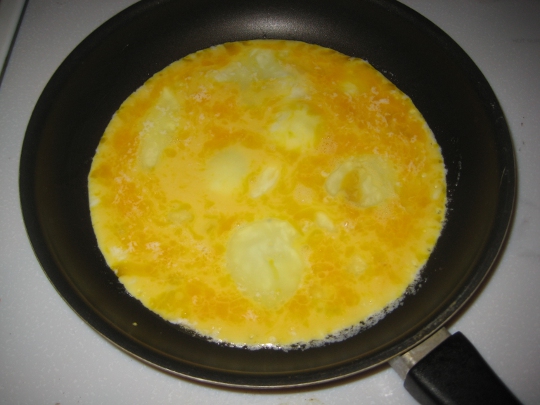
To make an omelette, you will need:
- A frying pan,
- Some butter,
- A spatula,
- A bowl,
- A whisk (or a fork),
- Some milk,
- Three eggs, and
- Ingredients of your choosing (I used mozzarella cheese)
Cover the pan with copious amounts of butter (and it is important that it is a non-stick pan!), and set the burner to a medium heat. Crack your eggs into a bowl, drop in a little bit of milk in there as well (1 tablespoon or less per egg), and whisk everything until it is a consistent color throughout. Once the butter is all melted and evenly distributed, pour out your egg milkxture into the pan, and wait. As you wait, you can check it periodically by slightly tilting the pan at an angle. You will probably see some of the liquid fall into whatever direction you tilted it while it is still cooking. Quickly tilt the pan back to being level again. When the liquid has really minimized, so that there isn't much left of it at all, then add your ingredients.
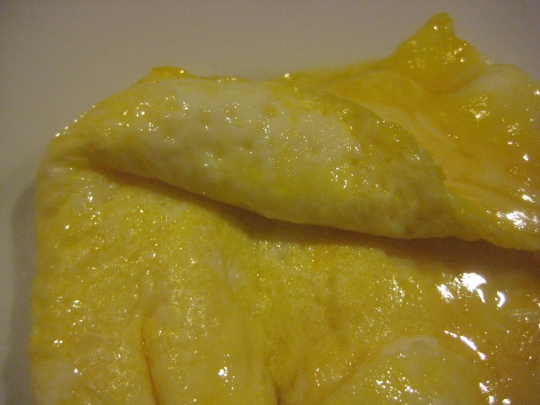
I decided I was going to attempt this omelette in the French style - aka a trifold omelette. The alternative is the American style (a bifold omelette), but I figured the French style would be fancier and more difficult to pull off. I was right. So much so, in fact, that I did a miserable job with it. More on that in a second. To cook an omelette the French style, you'll want to make sure you lay out your ingredients (in my case it was just cheese) in a straight line right down the center. Placement matters with the French style. Placement doesn't matter at all, however, with the American style; then you can just throw the ingredients wherever you like, since it will be flipped over on itself anyway. But for the French style, let it cook about another 45 seconds to a minute (making sure all the liquid is gone), then take your spatula and pull one third of it over the center, and then the other third of it (on the opposite side) right over that. Then grab the whole thing, and flip the whole thing over onto your serving plates, so that the two pieces you flipped over the center are now facing down.
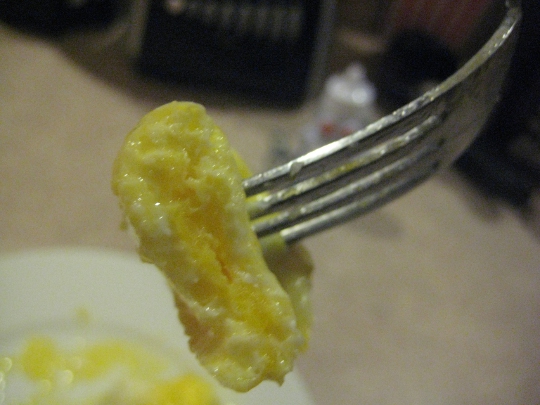
I've strategically chosen the pictures to showcase on this post, because they are the ones that are zoomed in close enough so that it's not obvious that I did a terrible job with this omelette. But rest assured, I did a terrible job with this omelette. I need more practice. I actually ended up making two 3-egg omelettes tonight. The first one I did on a pan that was not a non-stick pan, which was a mistake. The second one I did in a smaller pan, but when it came time to do the flipping, I just didn't have control of the thing with the spatula, and I ended up turning the bottom half of the thing into a goopy mess (which is why I only showed the top piece). As you can see from the last photo, it was still nice and fluffy, so the flavor was at least satisfying. But my technique needs some work. This was only 1-star kitchen material at best.
For some reason, even though the chemical makeup is exactly the same as scrambled eggs, I still prefer scrambled eggs over omelettes. Then again, if someone with actual talent was doing this, and with the right combination of ingredients, perhaps that could change my mind. I don't know. Normally I would have attempted this again and again, until I got it right, but because of some dental work I'm having done tomorrow morning, I have strict instructions not to eat anything after midnight tonight. So... my Ten-Egg Challenge has to come to close in a somewhat unsatisfying way, with a poorly constructed omelette. But this won't be the last time I ever make eggs, so I will have further opportunties to perfect my own abilities. Overall, though, I must say that I am grateful I took on this challenge, as I feel much more prepared in the kitchen now, plus I've picked up some new favorite breakfast dishes! I'd strongly encourage anyone who's curious and motivated to try the whole challenge for themselves.
And now I'll go back through and rank everything on a scale of 1 to 10. I'm also going to give myself the requirement that I only use each number between 1 and 10 once, so that the ratings are actually useful to you. I'm giving the omelette a somewhat harsh 3 out of 10, but I fully admit that may be biased just because I'm still pretty bad at making them.
The Ten-Egg Challenge: Part 9
Day 9: Eggs in a Basket
I couldn't make up my mind for what style of egg I wanted to cook for the penultimate day of the Ten-Egg challenge. I went back and forth for awhile; I considered doing a basted egg, a medium boiled egg, and even a shirred egg, but finally decided on eggs in a basket. Basting an egg isn't really so much a unique type as it is just a different style of cooking sunny side up eggs. Medium boiled is really still a soft-boiled egg at heart, only chunkier. And a shirred egg isn't something you'd ever order at any breakfast place; it more resembles cooking a casserole than making breakfast. But eggs in a basket is a fairly popular style, and even though the egg part of it only comprises half of the ingredients, it is still an egg at heart.
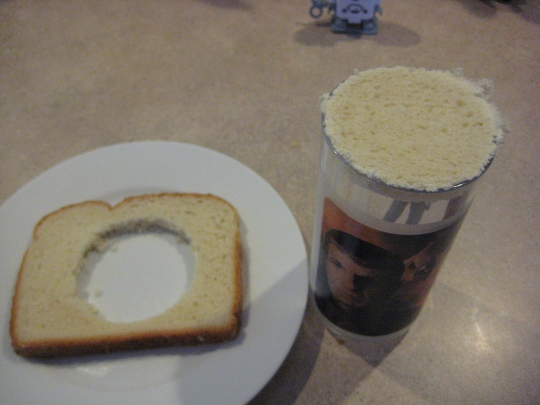
To make eggs in a basket, you will need:
- A slice of bread,
- A cup,
- Lots of butter,
- A frying pan,
- A spatula, and
- An egg
Begin by greasing the pan with copious amounts of butter, and setting the burner to a medium heat. Keep in mind that you will actually have to add in more butter as the process continues. Take the cup and use it to cut a hole out of the middle of your slice of bread. I considered doing shapes more creative than just a plain old circle, like a star or a silhouette of godzilla, but since this was my first time ever making eggs in a basket, I decided it'd be better to just focus on the flavor than the flair - this time around. (By the way, as you can see from the picture above, I actually used one of my Star Trek glasses as my "cookie cutter." I won a set of these glasses for winning the weekly football pool at my office.) Once the butter has melted, drop your piece of bread in the pan (this is called the "basket"), and also drop the cut-out piece of bread in the pan, too, but not in its original hole. This piece is called the "hat." Then crack an egg into the hole in the basket, and wait.
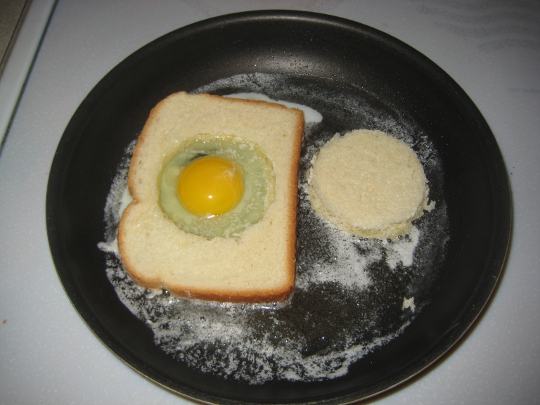
After about a minute or so, when the egg whites have fully solidified, take your spatula and give the whole thing a flip. Also flip the hat. At this point, drop a few globs of fresh butter into the pan, and spread everything around so that the bread absorbs the butter on both sides. You'll find that flipping this is actually a lot easier than flipping a regular egg on its on. The reason is because the bread already has a firmness to it that's easy to manipulate, and as the egg cooks it latches onto the bread and becomes one with it, much like the parasitic relationship that a male angler fish has with a female.
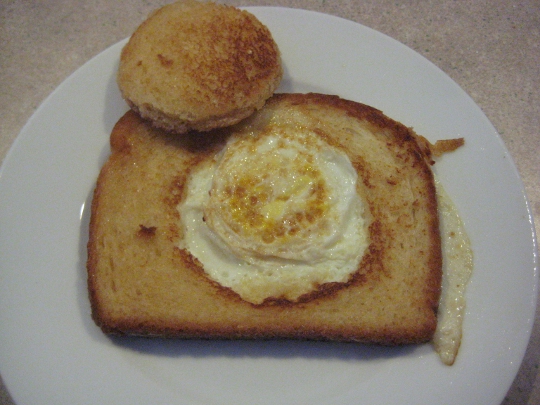
Once it's been flipped, let it cook for another minute or so. You can kind of decide your own timing system here depending on how runny you want the yolk to be. Less time means more runny, more time means more like hard boiled. Then when time's up, use the spatula to flip it back into its original position and onto a serving plate. The egg should hold on tightly to the bread. And you can just place the hat wherever you like. As you can see in the picture, I placed mine askew on the eggtoast's head, as if it were looking up and saying to me, "hats off to you Gordon, why don't you have me for breakfast."
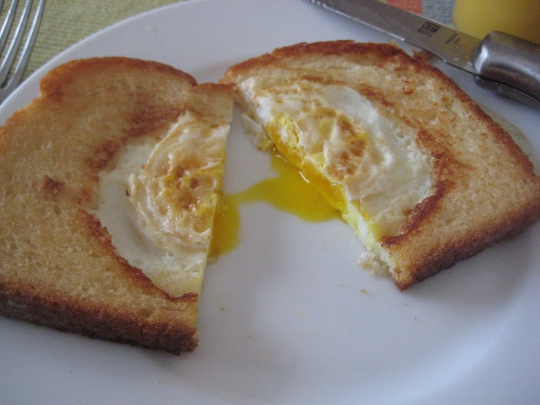
The results? Decent. The bread looks exactly like toast looks, which leads some people to refer to this style as "egg and toast." The texture of the bread is even the same as toast, but the flavor is distinct. It's not toast, strictly speaking; it's fried bread, which does taste a little different than toast. All the many attempts I spent yesterday trying to cook the perfect over medium egg must have finally sunk in, since it just so happened to turn out over medium today with a partially runny yolk. Eggs in a basket get a middle of the road 6 out of 10 from me.
And now I must bid you adieu, dear blog readers, since it is snowing like crazy outside and I'm going to go SLEDDING. :} Check back tomorrow for the final challenge!
The Ten-Egg Challenge: Part 8
Day 8: Over Medium
You may recall that I originally attempted to cook over medium on day 6, but it accidentally turned out as over hard instead. Today I tried again - and again, and again. This morning I woke up, put in 45 minutes on the elliptical machine, took a shower, and then tried to cook myself a breakfast of an over medium egg. Unfortunately, as soon as I sliced it open with a knife, I saw right away that my first attempt was actually an over easy egg. D'oh. So onto take 2. After thoroughly washing everything and starting fresh, I tried again with a second egg. (My egg flipping skills are quite good now, by the way!) The results? Over easy again. D'oh. Not that over easy is wrong - in fact it made for a very tasty breakfast...twice - it's just not what I wanted to do. Finally though, the third time was the charm. This afternoon I tried again and came out with what I will consider to be a successful over medium egg. And regarding my two failed attempts this morning, you know what they say... you can't make an omelette without cracking a few eggs first.
And I'll show myself out.

Here's what you'll need to make an over medium egg:
- A frying pan,
- A spatula,
- Some butter, and
- An egg
This is still the same list of requirements for both over easy and over hard of course. Grease the pan with copious amounts of butter, and heat it up to a medium-high heat. I've given that instruction ("use copious amounts of butter") on a couple of different challenge days now, so in case you were wondering what I mean by that, I've showcased a photo of the pan with butter freshly applied to it above. That's my definition of copious. Of course once the heat gets going it starts to melt and you want to make sure it gets spread over the whole surface of the pan. Then, crack the egg open and wait for about a minute and a half. That will be when the egg whites have fully solidified and then some. Then give 'er a flip! And from there wait exactly one minute, at which point you promptly turn the burner off and transfer the egg onto a serving plate.
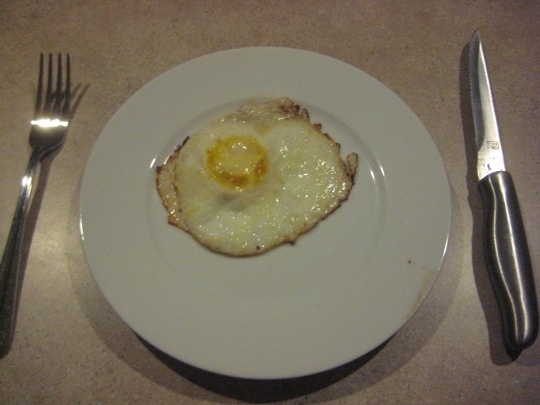
On my first two attempts earlier this morning, I had tried this on a medium heat (which is the same instruction I gave for over hard on day 6). But since both of those turned out under-done, I just decided to crank up the heat on the stovetop to medium-high instead, and thankfully that did it. An over easy egg is all goo in the center; an over hard egg is all fluffy stuff, while an over medium is (not surprisingly) half and half. You'll have some goo, and some cooked yolk too. On day 6, when I cooked the over hard egg, I actually did have a few drops of goo there, too. But, it was so little that I don't think anyone would have taken me seriously had I tried to pass that off as over medium, so it just got designated over hard.
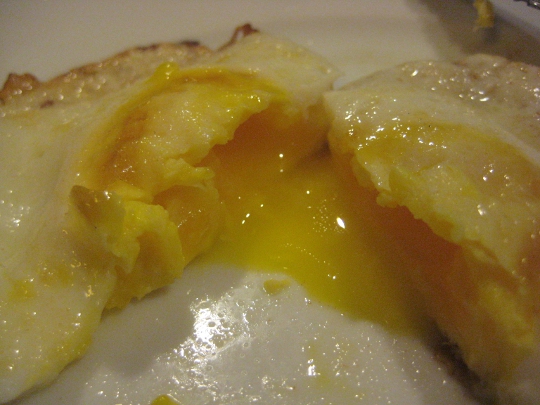
The results? Decent. I think I preferred the two accidental over easy eggs I had for breakfast this morning over the final over medium egg this afternoon, as the closer the yolks get to being hard boiled, the less I like them. The exception of course is with scrambled eggs, but that's probably mostly due to the fact that the egg white is mixed in there as well. With two bad eggs along the way, so far over medium has proved the most challenging. And honestly, I still think I did a pretty poor job. As you can see in some of the pictures, the edges started to brown - which was due entirely to the higher heat. So I think I'll just leave over medium to the professionals, and hope that I don't have a daughter or son one day who picks over medium as their favorite. I give it a 5 out of 10. Other things I learned today: Christmas shopping is expensive! The bill from the post office, for just the Christmas cards plus stamps alone was over $100! I love sharing cards with friends though, so it's all worth it. ![]()
Check back tomorrow for the penultimate egg challenge. Only two days left! What will I cook up next?
The Ten-Egg Challenge: Part 7
Day 7: Soft Boiled
Tonight I had another late start on the egg challenge. I had a pretty full day - getting into work bright and early at 7, followed by a haircut, shopping, and then a nice evening with some church friends. When I finally got home (around 10), I got started on this egg right away. Fundamentally, the idea behind preparing a soft boiled egg is actually quite simple. But this little egg gave me quite a bit of grief. They're traditionally served out of something called an "egg cup" (here's an example) which I learned are remarkably hard to find.
On day 1 of this challenge, I knew that I'd be including this style of egg on the list, so I started looking for them right away. I visited Target and a local dollar store, but could not find them. And since I have about a two-store shopping threshold, I gave up and decided to order one off Amazon instead. I went with the cheapest shipping option, but it still cost more than the egg cup itself. I got an email saying my egg cup had shipped the next day, but I didn't notice until this afternoon that the actual estimated date of arrival isn't until January for some reason. But with only four days left in this challenge (if you include today), I knew I had to find an alternative. So after work today I searched Kohls, Walmart, a local variety store, and then the dollar store again. None of them had egg cups - in fact no one that I asked had ever heard of an "egg cup" before. Fortunately, I found a shallow candle holder at the dollar store that looked like it was just about the perfect size. And indeed it was!
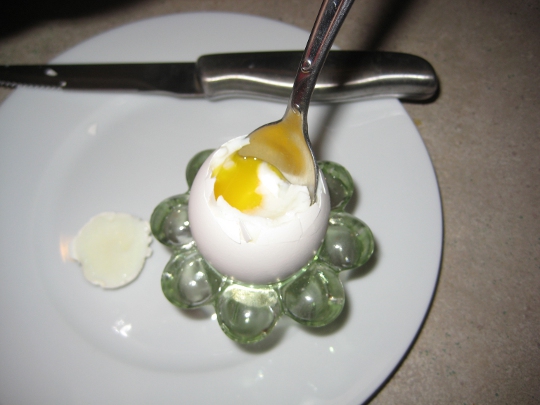
Here's what you'll need to make a soft boiled egg:
- An egg cup,
- A pot of water,
- Some tongs (or a spoon),
- A knife, and
- An egg
Fill the pot with cold water, and make sure it's nice and full so that the egg will be fully submerged when you put it in. Gently put the egg into the cold water right away, and set your stovetop to high so that you can boil the water with the egg in there. Although they say the watchpot never boils, you're going to have to watch it pretty carefully. The timing has to be very precise with a soft boiled egg. Wait too long and you'll have yourself a hard boiled egg. Fail to wait long enough and you'll just have an uncooked egg. Tonight, as I was cooking this, I have to confess that my first attempt was a failed one. I had everything lined up, when I got finished I even set the egg up in my fake egg cup / candle holder and got my digital camera ready to show it off to the world. But alas, instead of cutting it open and finding a soft boiled egg, I wound up with a hard boiled egg. That has been my first real failure on this challenge. (And now I'm going to have to get additional eggs from the grocery store in order to complete this challenge - boo!) But my second attempt turned out perfectly.
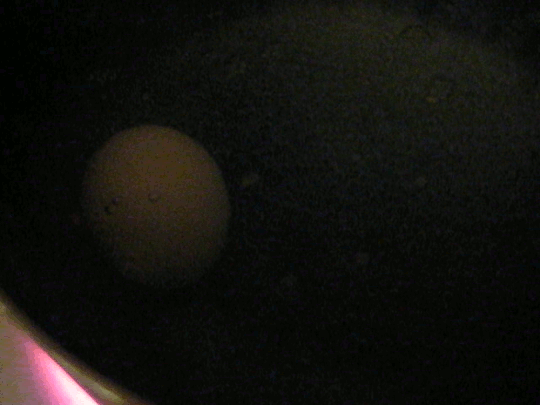
When water goes from cold to boiling, it goes through many different phases along the way. One of these phases, which occurs just a few minutes after being put on the stovetop, is that the whole bottom of the pan will be covered with little air bubbles. And what happens next is that those little air bubbles will start to slowly trickle upwards. As soon as it starts doing that - as soon as you see a slow trickle of air bubbles - you'll want to start a timer. I've showcased a picture of what that looks like above. Once you see that slow trickle of bubbles, set your timer for exactly 4 minutes. By the time the 4 minutes is up, the pot of water might not be completely boiling (though it should be close) - and that's okay. Then, at 4 minutes sharp, use the tongs to remove your egg from the boiling water and do one of two things: either (1) run it under a constant stream of cold water, or (2) place it gently in a big bowl of ice water. When I cooked the hard boiled egg on day 5, I used the stream of water. Tonight, I prepared a big bowl of ice water before I started anything else, so I just dropped the egg in there. I only left it in there for about 20 seconds; this cools it to the point where you can comfortably hold it, but the inside will still be nice and warm.
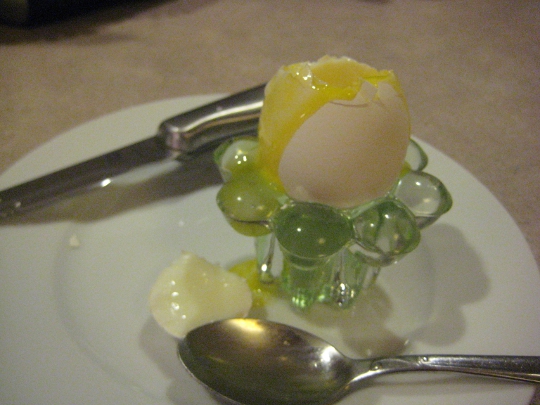
Then, I moved the egg out of the water and into my "egg cup" (which fit surprisingly well!), and took a knife and started tapping towards the top. You basically have to do brain surgery on a soft boiled egg, by surgically removing the top cap and then diving in with your spoon to pull out all the gooey innards. Here's a video of the proper technique. The results? Like I said, the first time I tried this, I was quickly disappointed to learn that I had just made a hard boiled egg. Timing is really key! But on take 2, it turned out beautifully. The yolk was still completely runny, but nice and warm and tasty. You could tell it was cooked, but still liquidy. And it was delicious! I still prefer the fried taste - over easy was pretty darn good - but this wasn't half bad. All the hassle of running around futilely trying to find an egg cup and of having to take a mulligan during cooking eventually paid off in the form of a very tasty egg. So whenever my real egg cup from Amazon does finally arrive, I'll have to make this style again. I'm giving this one a 7 out of 10. Tune in tomorrow (technically speaking today) to see what's next. There are only three styles of eggs left in this challenge!
The Ten-Egg Challenge: Part 6
Day 6: Over Medium Over Hard
Tonight's egg post comes to you much later than usual, because I didn't get home until 9:30 PM! I left straight from work to drive over to the Young Shakespeare Player's Theater on West Lawn Avenue in downtown Madison. They are a remarkable little organization - more on that later. The short and short of it is one of my Sunday School students was performing in their rendition of "Twelfth Night" this evening. So I finally got home just now, and the first thing I wanted was dinner. And the first component of that dinner was this over hard egg.
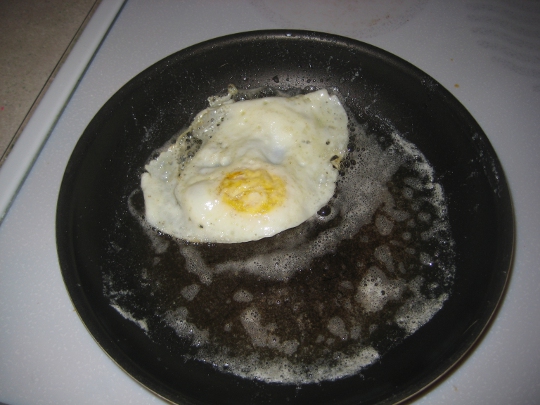
Here's what you'll need to cook an over hard egg:
- A frying pan,
- A spatula,
- Some butter, and
- An egg
Notice that this is the same list of requirements as for Over Easy eggs, since the only ingredient that varies between the two styles is time. The instructions start out just the same: grease the pan with copious amounts of butter, making sure it spreads over the whole surface of the pan, and heat your burner to a medium heat. Then crack the egg in and wait, just as you would with over easy. I said last night that I had come up with an idea to help improve my egg-flipping abilities. I stole a canister of pink Play-Doh from the Sunday School at church last night ("stole" isn't the right word considering I was the one who bought it originally), and molded some of that into the shape of a fried egg. I took an extra pan and dropped my pink fake fried egg in there to practice flipping. I've actually put together a quick video of my attempts, which also includes the final actual egg flip at the end, too.
So continuing on... after the egg has been in there for about two or three minutes (the egg whites should of course be totally opaque), you give it a flip. As you'll see in the video, my egg flipping skills have improved dramatically! My theory is that if you're bad at something, just keep doing it repeatedly until you become good at it. You will. Plus, a little Rocky Balboa music doesn't hurt either. ![]() But back to the egg, you want to wait another two minutes or so, and then take it out of the pan and onto your serving plate. You'll know you've done it right if the yolk is solid, as pictured below. Now I do have a confession to make, which some of you have probably already picked up on from the strike-through lettering above. I had originally intended to cook an over medium egg tonight, but it wound up being over hard instead. But, you know, I was already planning on doing over hard as part of this challenge anyway, so it got moved up to tonight! The reason was I was so distracted thinking about the perfect flip that I left it on the burner longer than I had originally intended.
But back to the egg, you want to wait another two minutes or so, and then take it out of the pan and onto your serving plate. You'll know you've done it right if the yolk is solid, as pictured below. Now I do have a confession to make, which some of you have probably already picked up on from the strike-through lettering above. I had originally intended to cook an over medium egg tonight, but it wound up being over hard instead. But, you know, I was already planning on doing over hard as part of this challenge anyway, so it got moved up to tonight! The reason was I was so distracted thinking about the perfect flip that I left it on the burner longer than I had originally intended.
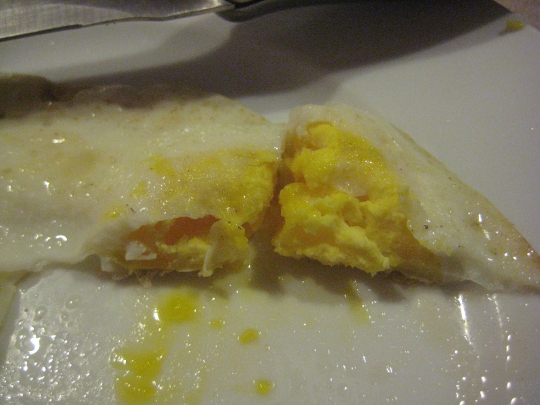
The results? If an over easy egg and a hard boiled egg had a baby, it would be a really bizarre chicken. And if that went on to lay an egg, it would be this over hard egg. I like the "over easy" part of this egg - the good, fried whites - but I'm not a big fan of the hard yolk. Again, it wasn't bad, per se; it's just not my thing. I'll give it a 4 out of 10. But as for the Shakespeare play I attended, it was INCREDIBLE! That gets a solid 11. I'll be going to that same theater again next week when another church member is taking part in a dramatic reading of Charles Dickens' A Christmas Carol. I had the privilege of seeing that story read, unabridged, in a dramatic style last year, and that was a real treat.
The thing about YSP is that they do everything unabridged. In the case of Dickens' Christmas Carol, that is wonderful. In the case of Shakespeare, well, expect three to four hours minimum per play. But I have to say, I really enjoyed Twelfth Night a lot! I admit I didn't totally know what was going on all the time, but I definitely picked up on the major plot points and all the innuendos. Shakespeare was no shrinking violet when it comes to innuendos. Check back tomorrow to see which kind I'm cooking up next.
The Ten Egg Challenge: Part 5
Day 5: Hard Boiled
On day 3, I remarked that scrambled was the easiest style of egg because you pretty much can't screw it up even if you wanted to. Hard boiled comes in a marginally-close second for ease. I have to admit that hard boiled eggs have never really been my favorite. I know that some people swear by them, and certain hotels even feature them as a staple of their continental breakfasts. But to me, hard boiled eggs just aren't a breakfast food. They're more of an add-on to other, real foods in my book. I cut them up and put them in my salads and casseroles, for instance. But on their own, they've never done it for me. And I have to admit I've always enjoyed the white part more than the yolk, even though I know the yolk is where all the protein is at.
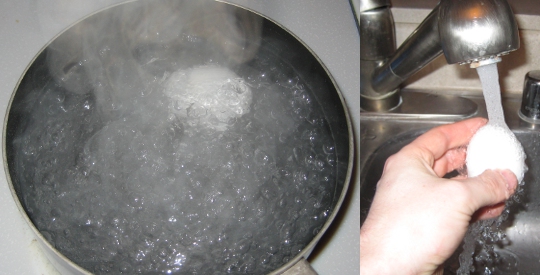
Here's what you'll need to cook a hard boiled egg:
- A pot full of boiling water,
- A pair of tongs (or just a spoon), and
- An egg
Seriously! That's all you need! While the other cooking styles call for things like butter, milk, and even vinegar, all that you need to make a hard boiled egg is an egg and water. Heat the water to bubble, bubble, toil, and trouble temperatures, then drop your egg in - gently, laying it down in the pot using your tongs. You obviously do NOT want any type of boiled eggs to crack. Then just wait. A good 12 to 15 minutes will do - so you want to make sure that your pot is large enough so that the water won't completely evaporate away over the course of 15 minutes. Then, when the time's up, take the pot off the burner, use your tongs to extract the egg from the water and put it somewhere else while you dispose of the water. Then, take the egg in your hand and (quickly) run it under a constant stream of cold water. Do this long enough so that egg cools down to a temperature that's comfortable to hold without burning your hand. This will halt the internal cooking process of the yolk and blah blah technical food stuff. Then, when it's cool enough to hold onto, give it a quick-but-firm tap on the top, and then just peel the eggshell away. Voila!
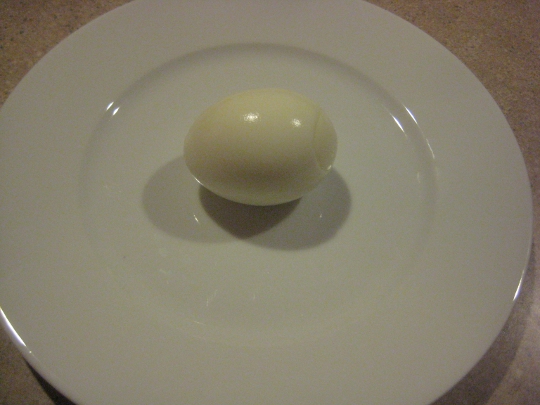
The results were exactly what I expected: a hard boiled egg. I would be in trouble if after 27 years of Western living I didn't know what a hard boiled egg tasted like. And as I said before, they don't do it for me as a standalone food. I'm giving it a 2 out of 10. I did add salt to the yolk tonight, and that certainly helped, as salt has a way of making anything better. And I'm not trying to imply that it's a bad taste, per se; I just prefer many of the other styles over this one. And I feel like I could make hard boiled eggs with two arms tied behind my back, so while I was preparing this egg I had a couple other things comprising my dinner cooking simultaneously on the stovetop. And Emerald was "helping" me cook tonight while I prepared this egg, too. For awhile she was dwelling in the secret place of the most cat (aka hiding in the cupboards).
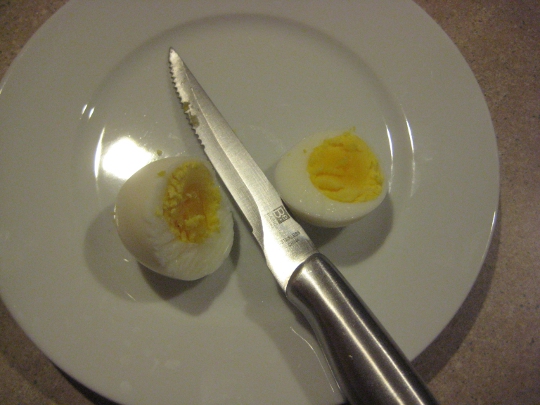
I picked a quick-and-easy style tonight because again I was busy. I have a somewhat regimented weekly schedule (I've actually been working on making it more regimented): on Wednesday nights at 7:30 PM, I attend the church service over at First Church of Christ, Scientist, Madison. Tonight's service had readings about Jesus' birth; it was very Christmassy. At every Wednesday service, anyone in the audience (whether they're a church member or not) has the opportunity to stand up and speak a "testimony." A testimony is simply an expression of gratitude for how God has been working in your life, giving specific examples. Often people talk about challenges and struggles overcome. I'm actually one of those standing up to praise God myself a lot of weeks at these services. So if you, dear blog reader, are in Madison, I'd love to have you join me for a service on Wednesday night! There's also an online form that allows people to submit their remarks in advance, to be read for them by someone else during the service (once screened). While no one has actually used this form yet, I think that's still nice to have. Sometimes it's easier to talk about things when you're "anonymous," and sometimes you just can't be there in person!
Lastly, if you've been following this challenge, you know that I was lamenting my poor egg-flipping skills last night with over easy. Well I've thought of an idea that should help me quickly improve. The only spoiler I'm going to give is that it is pink. Tune in tomorrow to see which kind of egg I cook up next. The challenge is already halfway done, and that is eggcellent. (Groan... well admit it, you knew I had to make that pun sooner or later.)
The Ten-Egg Challenge: Part 4
Day 4: Over Easy
Tonight I tried another style that I had never tried before. I learned a few things tonight. I learned that over easy is basically the same as sunny side up, except with one extra flip (which leads some people to refer to this style as "sunny side down"). And I also learned another lesson tonight: I am bad at flipping eggs. At least, for now. Right now I'm trying to type up this post super fast before I have band practice. More on that later.
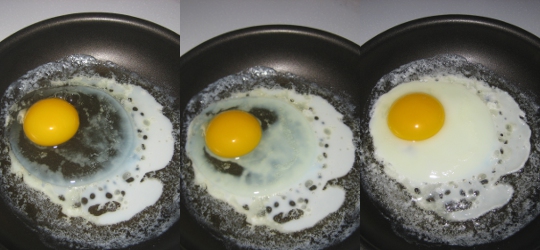
To cook an egg "over easy," here's what you'll need:
- A frying pan,
- A spatula,
- Some butter, and
- An egg
Grease the pan with copious amounts of butter and make sure it spreads around well. Heat the burner to a medium heat. Then just crack an egg in and wait! The waiting takes about two minutes or so - just until the egg whites have solidified. As you can see I have a diagram pictured above, showcasing an egg that is not ready for a flip, then almost ready, and finally ready. Once it reaches the point where the whole of the whites are opaque (but the yolk is still bright yellow), you want to give it a flip. I've seen that the master chefs do this without a spatula - they actually just flip the egg up into the air using the pan and then catch it flawlessly. Since I'd never cooked this way before, and since I was in a rush, I didn't even attempt that. I just used a spatula. And I used a spatula poorly, as you can see below.
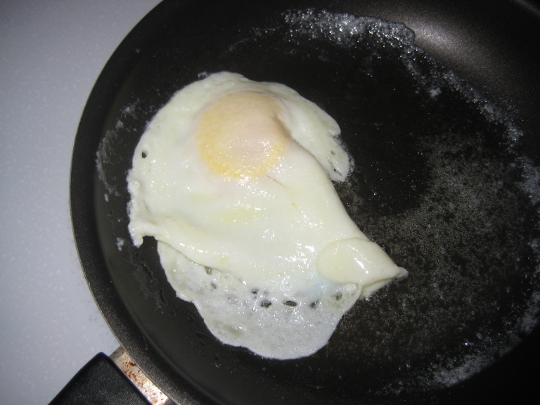
Once the egg has been flipped, don't touch it. Even if you did a miserable flip job like I did, resist the temptation to fix it, otherwise you might break the yolk. Just wait another 45 seconds for the bottom to cook over, and then using your spatula, remove it from the pan, flipping it back to its original orientation, and onto your serving plate. When cut open, the yolk should still be nice and runny. You can probably already guess two additional styles I'll be trying later on in this challenge: over medium and over hard. The fact that the whole yolk is still runny distinguishes this style from those.
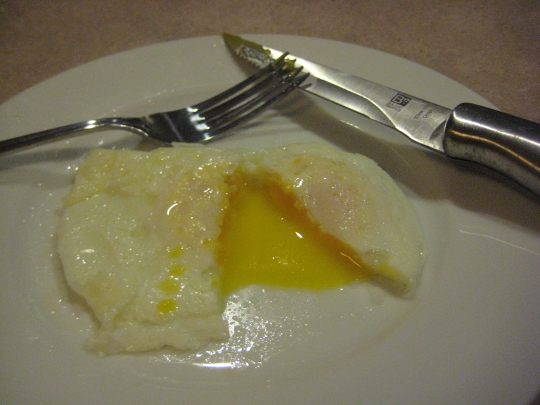
The results? Well, even though my egg may not have been the most aesthetically pleasing due to my presently poor egg-flipping abilities, it was extremely pleasing to my taste buds! In fact, I really wanted to make another one right after I finished this one! But, alas, I had to hold off, as I promised myself to use exactly 12 eggs for this challenge - no more, no less. I'll give this an 8 out of 10. Plus, I'm in a bit of a rush tonight because it's Tuesday, and on Tuesday nights I have band rehearsal. I play French horn in the Verona Area Concert Band, which is really a fantastic little group, run by conductor and Verona Area High School band teacher Eric Anderson. Our next free concert will be on Thursday, February 7th at the Verona High School, so if you're in the area, come check us out! I'm off to practice now; check back tomorrow to see which style I cook next!
The Ten-Egg Challenge: Part 3
Day 3: Scrambled Egg
Most of the eggs I'll be making for this challenge are done in ways that I've never attempted before. Scrambled is not one of those ways. I've done scrambled eggs many, many times before and I have a method to it to ensure they turn out perfectly. Of all the different styles, scrambled eggs get cooked the most and there's really no way to screw them up.
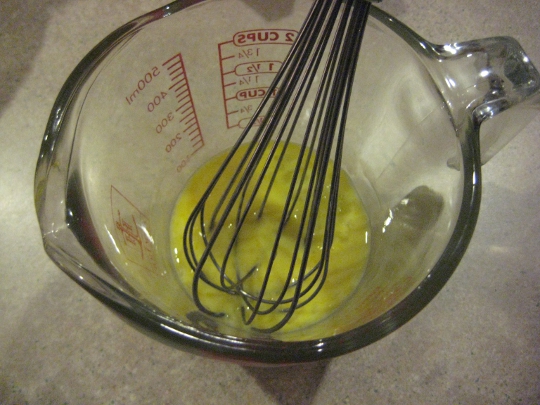
Here's what you'll need to cook them:
- A bowl,
- A whisk (or a fork),
- A spatula,
- Some butter,
- Some milk,
- A frying pan, and
- An egg
Because I only did a single egg, I used a measuring cup in lieu of a bowl. I like my eggs mixed up with milk because I think it gives them a lighter and fluffier texture. So begin by cracking your egg(s) into the bowl and adding in 1 tablespoon (or less) of milk per egg. Use the whisk to mix them all together until the color is consistent throughout. Grease the pan with butter (again I used copious amounts of butter - as a former roommate used to say to me, "the secret ingredient is butter") and set the burner to a medium-high or even high heat. Pour the egg-milkxture into the pan and let it sit there for about 1 or 2 minutes. Then perform a litmus test by prodding the side with a spatula. You just want to check if the bottom has solidified. The top is going to be bubbly and liquidy no matter what, but the bottom should harden up. Once it's hard enough to be flipped, flip it. Flip it good. (Cu-rack that egg!) Use the spatula to chop it up into bits, and flip the bits as necessary. Some people like to keep the egg in way too long until it actually starts to brown. That's way too long. I prefer my scrambled eggs still light and fresh, so as soon as all the liquidy parts are gone, it's done. Then just take the pan off the burner and slide it onto a plate!
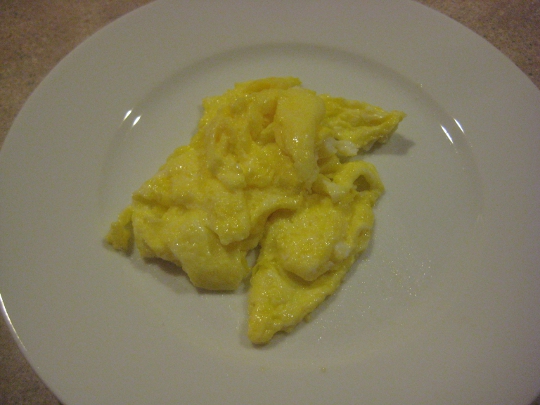
Scrambled eggs are my favorite, so of course the results were magnanimously delicious. As usual, I added salt to taste. Although, I have to admit that I really did enjoy that poached egg on Day 1, so perhaps by the end of this challenge I'll have some new favorites. Still, I'm doubtful that anything else can truly dethrone scrambled as king of the egg-cooking styles. One thing I should mention: because I mix my eggs with milk before scrambling them, you sometimes get white spots. That's okay, and is to be expected. As you can see in the photos, there really weren't any major white spots this time, but then I used a little less milk than I sometimes do.
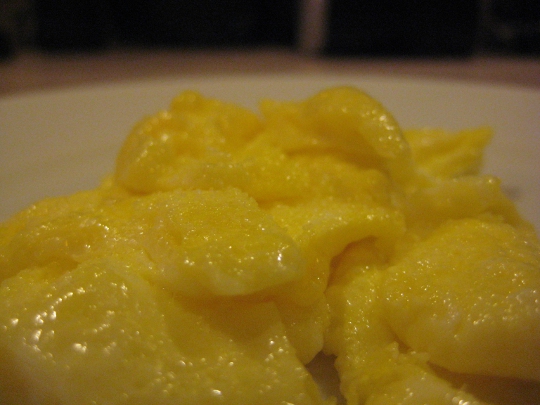
One of the reasons I picked scrambled tonight was because I was rather busy this evening (not that I'm not any other evening...) and they're a time-tested method for me that is quick and simple. My plans for the evening included typing up this post while listening to a live audio podcast called Every Day's a Celebration, and then watching the newest episode of a TV drama I'm addicted to. The online podcast was based heavily on an online, ecumenical project called Radical Acts. If you're not already familiar with Radical Acts, it's a program designed to encourage each of us to live Jesus' teachings more fully in our daily lives. Check it out!
Anyways, despite the fact that I got this post typed up and then lost all of it thanks to a browser glitch, and despite the fact that they canceled the latest episode of REVOLUTI![]() N so they could air "Blake Shelton's Not-So-Family Christmas" instead - two things that could otherwise ruin a perfectly good evening (okay, so perhaps "ruin" is exaggerating a bit) - these eggs were still good enough that I wasn't phased at all (well, maybe I was a little phased. I mean Blake Shelton? Really?). The only thing that could have made them better is bacon. Actually, to be precise, a breakfast consisting of a scrambled egg, a single piece of buttermilk toast, some strips of bacon, and a glass of orange juice is pretty much ambrosia in the morning. I know I said I would be coming back through these posts after completing the challenge to rank them, but I'm already going to give scrambled eggs a solid 10 out of 10.
N so they could air "Blake Shelton's Not-So-Family Christmas" instead - two things that could otherwise ruin a perfectly good evening (okay, so perhaps "ruin" is exaggerating a bit) - these eggs were still good enough that I wasn't phased at all (well, maybe I was a little phased. I mean Blake Shelton? Really?). The only thing that could have made them better is bacon. Actually, to be precise, a breakfast consisting of a scrambled egg, a single piece of buttermilk toast, some strips of bacon, and a glass of orange juice is pretty much ambrosia in the morning. I know I said I would be coming back through these posts after completing the challenge to rank them, but I'm already going to give scrambled eggs a solid 10 out of 10.
Check back tomorrow to see which style is next!
The Ten-Egg Challenge: Part 2
Day 2: Sunny Side Up
I'm continuing on with my Ten-egg Challenge with what is probably the most basic of all egg styles: sunny side up. But despite its ease to make, this is another style that, prior to today, I had never made before! And as I understand it, this style provides the foundation for a number of other styles I'll be trying out. Here's the completed egg:
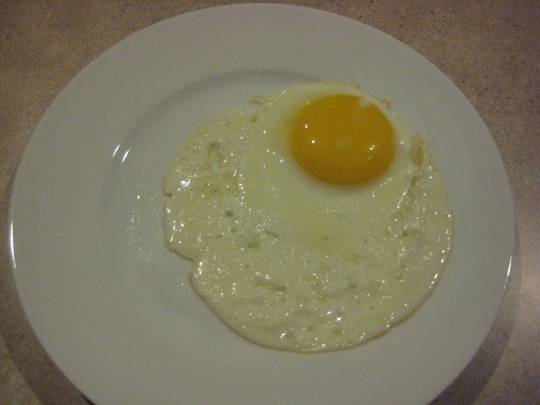
To make this type of egg, you will need:
- A frying pan,
- A little bit of butter,
- A spatula, and
- An egg
Grease the pan with butter - I actually used copious amounts of butter here, but that's not so bad - and heat it up on a medium heat, making sure the butter gets spread on the whole pan. Then just crack the egg and drop it in!
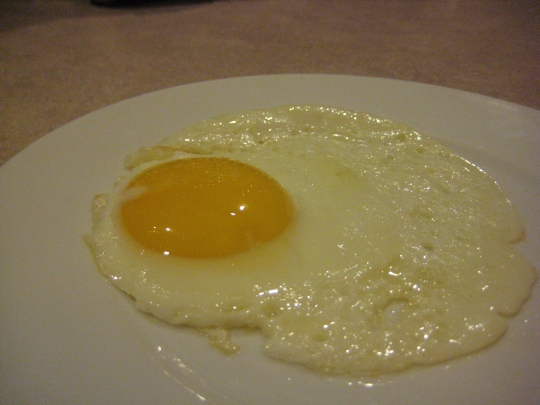
It doesn't take very long to cook an egg sunny side up, so you have to watch it carefully. I've heard that certain restaurants actually refuse to serve eggs this way because, of all the different styles, this borders the closest to serving raw egg. Of course you can leave it in the pan for longer to ensure it gets cooked better, but then there's also the risk of burning it on the bottom. On my very first try, it turned out perfectly. It wasn't too hot or too cold like the big or mid-sized bears, but cooked "just right," as Goldilocks says. It almost wasn't, though! At one point when I thought it looked ready, I softly touched the yolk and, lo and behold, it was still cold. Thankfully it's not rocket science, and obviously a cold yolk is not going to be something you'd want to eat. So... I let it continue cooking for another minute or two, before sliding it out of the pan with a spatula.
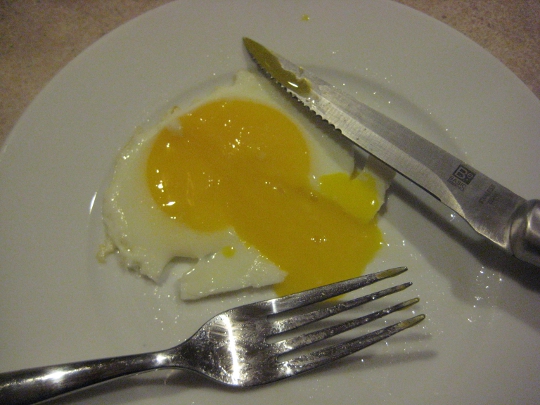
The results? Decent - but not my favorite. Not by a long shot. The egg whites were good, the yolk was nice and runny (but still cooked), and I added salt, as usual, because I like salt a lot. But I don't think I'll be ordering sunny side up eggs nor making them for myself any time soon. I'm giving this style the lowest score of all: 1 out of 10. It was edible but it didn't wow me. Still, now if someone else were to ask me to make sunny side up eggs for them, I would be able to comply and not look like a fool in the process! And that is a good thing; it's good to be prepared.
I made this egg this evening, just before writing this post and just after enjoying a chicken dinner. So I wonder if my disinclination to really get into this style was just the protest of the egg's mother on my taste buds? Honestly, it probably could have been improved if I knew anything about seasoning. But anyways, I've now successfully eliminated vegetarians from my blog readership! Mission accomplished. Tune in tomorrow to see which kind of egg I cook next. And I promise I'll start fulfilling the sub title of this blog soon by actually blogging about things other than food.
The Ten-Egg Challenge: Part 1
Hello world! After taking a several year hiatus from blogging, I'm back, but perhaps not with a vengeance. You may notice that my website looks nothing like it used to. For that, we have my good friend and coworker, Kristi Trefftzs, to thank. So a HUGE thank you to her!
Recently I was watching an episode of "Master Chef" where they had a challenge to the hopeful cooks to prepare an egg in four different ways: poached, sunny side up, soft boiled, and a 3-egg omelette. While some of the hopefuls were still relatively young, the masters insisted that anyone serious about cooking should know how to do eggs in all sorts of different ways by now. That got me thinking. I'm 27, and I've never cooked eggs in any of the ways they had called for in that challenge.
So, I'm setting out to fix this in what I'm calling the 10 Egg Challenge. This is a challenge that spans 10 days and should use exactly 12 eggs - assuming I don't break any. I'm going to challenge myself to learn 10 different styles of cooking eggs, and I'm going to chronicle my journey here on my blog.
Day 1: Poached Egg
This is something I'd never done before, and it's really not that hard. Admittedly, I suspect I'll probably be typing "it's really not that hard" every day of this challenge. But, you never know until you try it yourself. On every day of this challenge, I'm going to explain how to prepare the egg in this way. But before I do that, allow me to showcase a photo of the finished, poached egg:
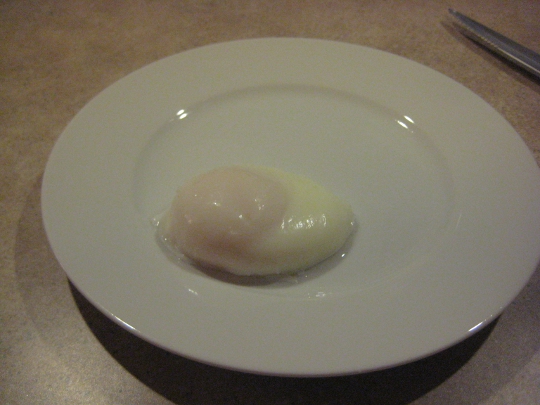
To make a poached egg, you will need:
- A pot full of water,
- 1 or 2 teaspoons of white vinegar (can be white wine vinegar or rice vinegar),
- A bowl,
- A slotted spoon, and
- An egg.
You want to make sure to fill the pot well, so that it's not too shallow; the egg needs some room to swim around in. Bring the water to a boil, and then immediately reduce the heat to a medium, or even low, simmer so that's it not bubbling any more. Then add your teaspoon(s) of vinegar. I didn't actually measure this; I just guessed. It doesn't need to be a precise science. But one thing to note: do not add any salt to the water! It will ruin the whole process if you do. Crack the egg into a bowl first (do not drop it directly into the water!), then hold the bowl just over the surface of the water so you can gently drop the egg in. Watch the egg. It should be fine on its own, but you can use the spoon to try to corral the whites around the yolk. But be gentle! You do not want to puncture anything.
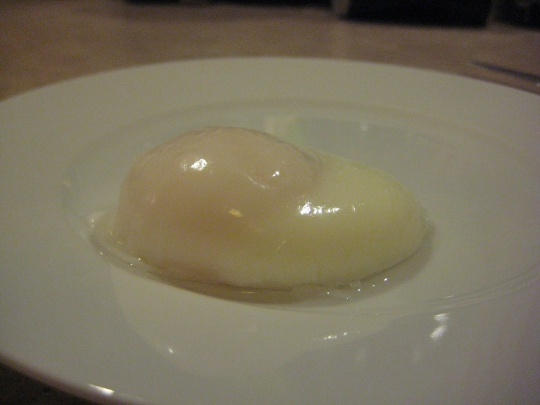
I found a number of websites that said you should keep the egg in the water for no more than 3 to 4 minutes. I kept mine in for about 5 or 6, though I may have used a slightly lower heat than others. Just watch it. Throughout the process, I would periodically take the spoon to lift the egg from off the bottom of the pan, still keeping it submerged in the warm water. After about four minutes, I gently picked it up with the spoon, out of the water, and lightly tapped it with my finger just to see if it was done yet. It wasn't. Thankfully I was gentle enough to not damage the egg, but I could tell it was still somewhat fragile at that point. After another minute or two, I tested it again, and it was more solid (though it still had some spring - which is good!). So at that point I turned off the burner, and used my spoon to pull it out of the water and onto a serving plate. There was an outermost perimeter of "messy" whites surrounding the inner solid whites. I used a knife and trimmed those off and threw them away, leaving only the perfectly formed poached egg.
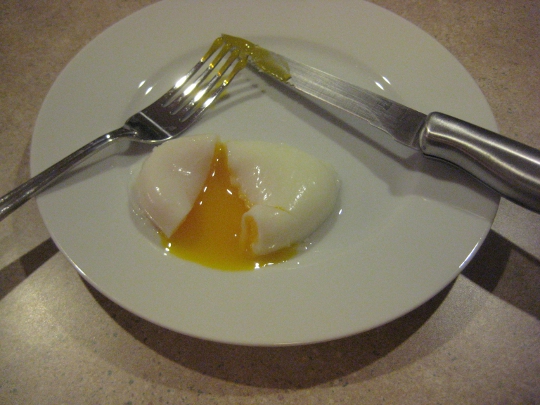
The results were delicious. The yolk was nice and runny, the egg whites tasted great, and I added the perfect amount of salt. I'm giving Poached Eggs a solid 9 out of 10. And in case you've ever wondered how to make "eggs benedict," you now know how. Eggs benedict is just an English muffin with ham and a poached egg (and usually Hollandaise sauce as well). So there you have it! So far I'm really liking this challenge. Check back tomorrow to find out what style of egg I'll make next!